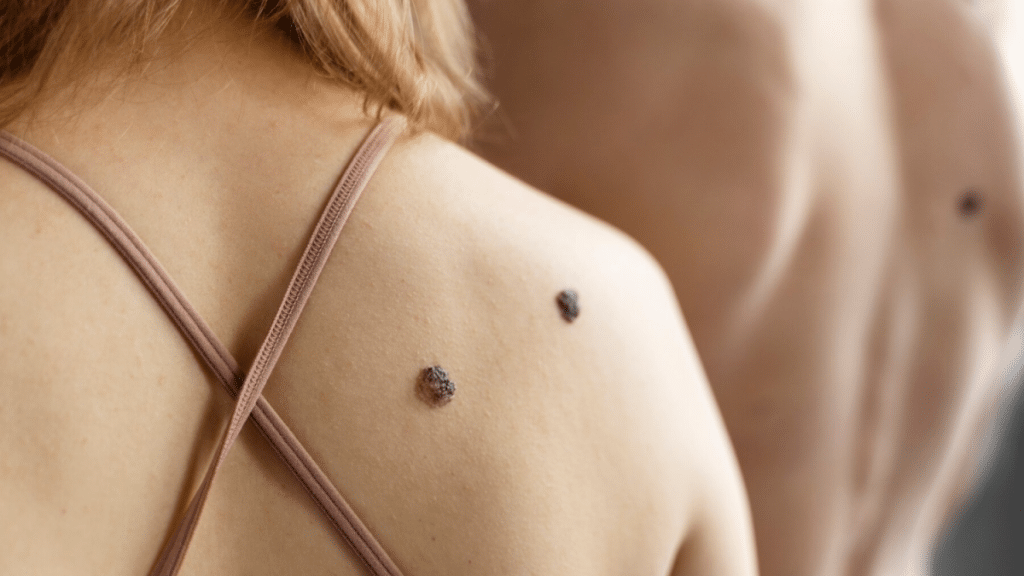Skin moles are small, often dark spots that commonly appear on the skin. Most people develop them in various shapes and sizes throughout their lives. In some cases, moles may change over time and require attention. For individuals concerned about mole changes, options like laser mole removal in Singapore provide an effective solution to maintain healthy skin. Knowing what to watch for can help ensure your skin stays in good condition.
Types of Skin Moles
There are several types of skin moles, each with distinct characteristics. Common moles are the most typical ones people see. They tend to be small, round, or oval with smooth surfaces. The color of these moles can range from brown to black or even pink, depending on your skin tone. Generally, they remain unchanged throughout life.
Atypical moles, also known as dysplastic nevi, are another type. These moles may look different from the usual common moles. They can be larger, have irregular shapes, or contain multiple colors. While they are not cancerous, they do indicate a higher risk of melanoma, a serious type of skin cancer.
Some people are born with moles, which are called congenital moles. These vary in size and color, with larger ones carrying a higher risk of becoming cancerous as a person ages. Lastly, a Spitz nevus is a pink, raised mole that can sometimes resemble melanoma, though it is typically harmless. If you notice a new Spitz nevus, it’s wise to get it checked by a healthcare professional.
Causes of Skin Moles
Moles form when skin cells grow in clusters rather than spreading evenly across the skin. These cells, known as melanocytes, are responsible for producing the pigment that gives moles their color. But what causes this cluster growth?
One major factor is genetics. If your parents have moles, you’re more likely to have them as well. This is especially true for congenital moles, which often run in families.
Sun exposure is another significant factor. The ultraviolet (UV) rays from the sun can cause melanocytes to produce more pigment, resulting in new moles or darkening of existing ones. People who spend a lot of time outdoors or live in sunny areas tend to have more moles. Even tanning beds, which emit UV rays, can trigger mole development.
Hormonal changes also play a role in mole formation. For example, during puberty or pregnancy, many individuals notice changes in their moles. Some may develop new moles, while others may observe alterations in their existing ones, such as color changes or growth.
Are Moles Dangerous?
Although most moles are harmless, monitoring them for any changes is essential. Moles that grow, change shape, or alter color could be a sign of skin cancer, particularly melanoma. Knowing what to look for can help catch any problems early.
Doctors recommend checking moles for signs of asymmetry, where one half of the mole doesn’t match the other half. You should also pay attention to the edges of the mole; if they become uneven, ragged, or blurred, it’s a warning sign. The color of the mole is another factor; if it has different shades or an uneven tone, it may need closer monitoring.
The size is also important. Moles larger than 6mm (about the size of a pencil eraser) are worth noting. If a mole starts evolving in any way, such as changing in size, shape, or color, you should see a dermatologist. Early detection of melanoma is key, as treatment is much more effective when the condition is caught early.
Preventing Problems with Moles
Although you can’t prevent moles from forming, you can take steps to reduce the risk of complications. The first step is to protect your skin from UV exposure. Wearing sunscreen with at least SPF 30 can help block harmful rays. It’s important to apply it to all exposed areas of your skin, even on cloudy days, and to reapply every two hours, especially after swimming or sweating.
Staying out of the sun during peak hours, typically between 10 a.m. and 4 p.m., is another way to protect your skin. Wearing long sleeves, wide-brimmed hats, and sunglasses can also help shield you from harmful UV rays. It’s also a good idea to avoid tanning beds, as they emit concentrated UV rays that can increase your risk of melanoma.
When to Seek Medical Advice?
Most moles don’t require any medical attention. However, it’s important to stay vigilant and consult a doctor if you notice any unusual changes. If a mole suddenly appears after age 30, that’s another reason to get it checked. Similarly, if a mole becomes itchy, starts to bleed, or causes pain, it’s time to schedule an appointment with a dermatologist.
Regular skin checks at home are also important. By examining your skin regularly, you can track any changes early. In addition to your self-checks, it’s a good idea to have an annual skin exam by a dermatologist, especially if you have a history of sun exposure, a family history of skin cancer, or a large number of moles.
Conclusion
Skin moles are common and, for the most part, harmless. Monitoring your moles for changes and taking precautions, like wearing sunscreen, can reduce your risk of serious skin conditions like melanoma. If you ever feel unsure about any changes in your moles, it’s always best to seek advice from a healthcare professional.
